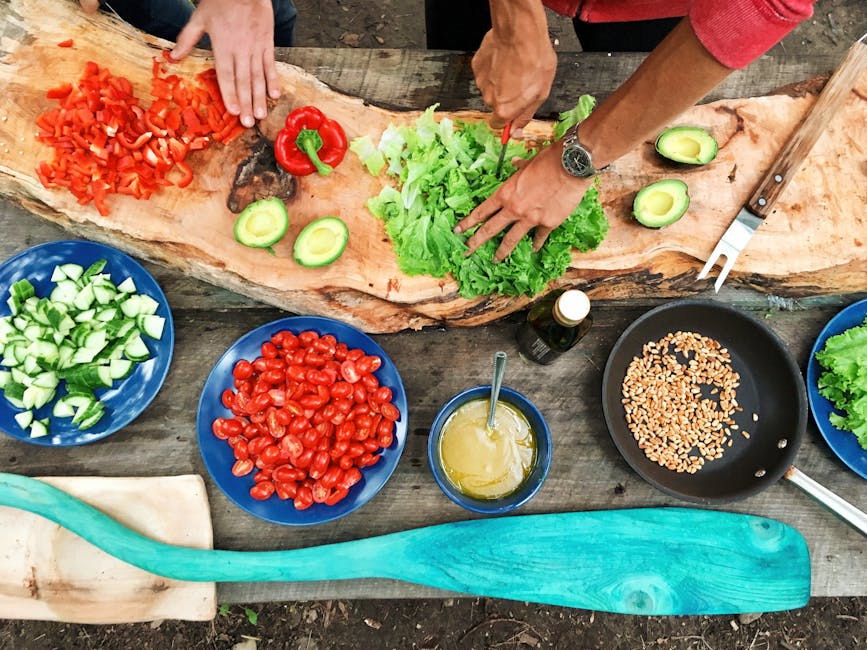Cooking with Colors: Discover Nutritional Benefits & Flavor Today!
Cooking is not just a science; it's an art that paints our plates with a stunning array of colors—each hue holding a unique promise of flavor and health benefits. In a world where visual appeal is central to meal experience, understanding how to use color can not only enhance your culinary creations but also contribute significantly to your well-being. From vibrant reds to deep emeralds, each color in our food can unlock the potential for a healthier lifestyle and more enjoyable meals. Let’s dive deep into the color spectrum of food and explore how cooking with colors can transform your kitchen and health.
The Science of Colors in Food

Color is one of the first attributes we notice about our meals; it can evoke memories, trigger emotions, and even influence our appetites. The association between color and flavor is well-documented. For instance, bright colors often indicate richer flavors and higher nutrient levels.
Fruits and vegetables owe their vibrant colors to phytonutrients—these compounds are linked to various health benefits. Red foods like tomatoes and strawberries are high in lycopene, associated with heart health. Orange and yellow foods like carrots and citrus fruits are rich in vitamin C and beta-carotene, beneficial for eye health. Green foods, such as spinach and kale, are packed with chlorophyll and fiber, promoting digestion and detoxification. Understanding this colorful connection allows us to create visually appealing and nutritionally balanced meals.
Why Cook with Color?

Cooking with a variety of colors means infusing your meals with a spectrum of vitamins, minerals, and antioxidants. This not only promotes overall health but also makes your dishes visually striking. Engaging multiple senses enhances the dining experience—a topic further explored in our piece on how music transforms your culinary experience.
Moreover, adding color to your meals makes it easier to meet daily nutritional requirements. The concept of “eating the rainbow” encourages individuals to consume a wide range of nutrients by simply choosing a diverse plate.
Culinary Color Combinations and Their Benefits

When creating meals, consider integrating these colorful foods to maximize both aesthetics and health benefits:
Red: Power and Passion

Red foods are often vibrant and flavorful. Think of roasted red peppers, beets, or juicy cherries. These foods are rich in anthocyanins and vitamins, which can aid in cell protection and reducing inflammation.
Recipes:





- Roasted Beet Salad with Feta: Combining roasted beets with creamy feta creates a delightful contrast in flavor and texture.
- Tomato Basil Bruschetta: Fresh tomatoes drizzled with balsamic reduction on toasted bread make for a stunning appetizer.
Orange and Yellow: The Sunshine Spectrum

Fruits and vegetables like oranges, sweet potatoes, and bell peppers fall into this category. These foods are excellent sources of vitamin C, enhancing immune functions and skin health.
Recipes:
- Spicy Carrot Soup: This vibrant soup, flavored with ginger, provides warmth and comfort during chilly months.
- Sweet Potato Hash: Sautéed with onions and garnished with fresh herbs, this dish is both colorful and nutritious.
Green: Freshness and Vitality

Green foods symbolize freshness and vitality. Spinach, broccoli, and avocados are powerhouses of nutrients; they're calming and nutritious and filled with fiber, aiding in digestion.
Recipes:
- Kale and Quinoa Salad: Tossed with lemon dressing, this salad provides a crunchy, nutrient-dense option for lunch.
- Avocado Toast with Radishes: A simple but elegant dish that enhances your morning routine.
Blue and Purple: Elegance on a Plate

Blueberries, eggplants, and purple cabbage bring sophistication to your meals. Rich in antioxidants, these foods can help to combat oxidative stress.
Recipes:
- Eggplant Parmesan: A classic Italian dish with layers of flavor and texture, showcasing the beauty of purple foods.
- Blueberry Smoothie Bowl: A refreshing breakfast that’s as colorful as it is nutritious.
White and Brown: The Subtle Styling

Though often overshadowed by their colorful counterparts, white and brown foods—like garlic, cauliflower, and mushrooms—are vital allies in enhancing flavor and boosting health.
Recipes:
- Mushroom Risotto: A creamy dish that highlights the umami flavors of mushrooms, while being easy to prepare.
- Garlic Mashed Cauliflower: A low-carb alternative to traditional mashed potatoes, offering a subtle flavor profile.
The Art of Plating: A Feast for the Eyes

Plating is where the color palette comes alive. The visual aesthetics of a dish can stimulate appetite and enhance the dining experience. When arranging your meals, consider contrasting colors that make each element pop. For instance, placing bright green peas on a vibrant orange sweet potato puree can offer a stunning visual appeal.
Tips for Beautiful Plating:

- Use White Plates: These allow colors to stand out.
- Elevate the Heights: Stack ingredients or use a ring mold to add dimension.
- Garnish Thoughtfully: A sprinkle of fresh herbs or edible flowers can add a final touch of color.
Beyond Health: The Emotional Connection of Colors

Colors can also evoke emotions, influencing our mood and feelings about food. This relationship is explored in our post on how mood influences cooking choices. For instance, the vibrant hues of food can induce happiness and appetite. This emotional aspect can enhance your culinary creations, making each dish resonate on a deeper level.
Engaging with Colorful Culinary Trends

Over recent years, culinary trends have leaned heavily towards vibrant dishes that celebrate plant-based eating. This evolution not only emphasizes the health benefits of colorful foods but also promotes sustainability. Additionally, exploring cooking with colors aligns perfectly with the modern desire to create visually appealing meals that cater to a variety of tastes and backgrounds.
The intricate relationship between color and flavor should not be underestimated. Dishes that celebrate color can elevate your cooking and dining experiences while improving overall health.
Practical Strategies to Begin Cooking with Color

If you're ready to embark on your colorful cooking adventure, consider the following practical steps:
- Plan Colorful Meals: When planning weekly meals, aim to include at least three colors on your plate.
- Explore Seasonal Options: Engage with seasonal produce by visiting local farmers' markets to find the freshest colorful ingredients.
- Experiment and Innovate: Don’t hesitate to try new recipes or create your own. Let your creativity flow as you combine flavors and colors in unexpected ways.
Final Thoughts: Create a Rainbow in Your Kitchen
Cooking isn't merely about sustenance; it's about experiencing life through flavor and color. By exploring the nutritional benefits and taste profiles of various food colors, you can transform your meal-preparations into a healthful, joyous practice. From the allure of vividly-colored fruits and vegetables to the emotional resonance of your crafted dishes, the experiences gained from cooking with colors offer enduring rewards.
Embrace this colorful approach to cooking and watch how it transforms not only your meals but also your health and happiness. You owe it to yourself to be adventurous in the kitchen! As you explore these delicious combinations, consider the insights presented in cooking with colors for health and flavor to further enrich your meals.
Let your kitchen be a canvas for creativity, where every dish serves both as nourishment and as a dazzling representation of artful cooking.



